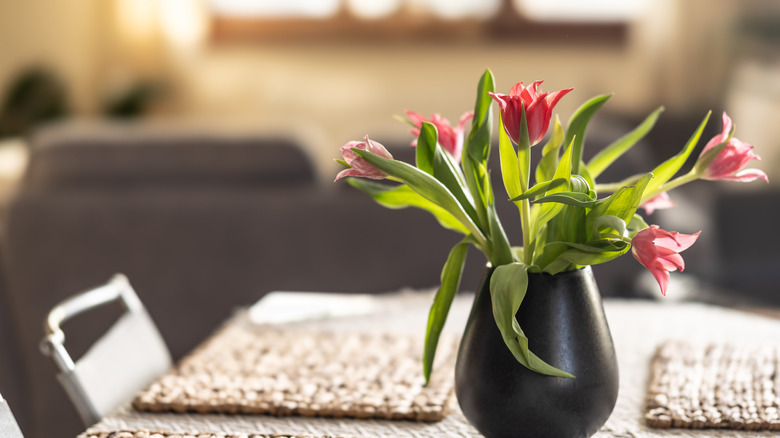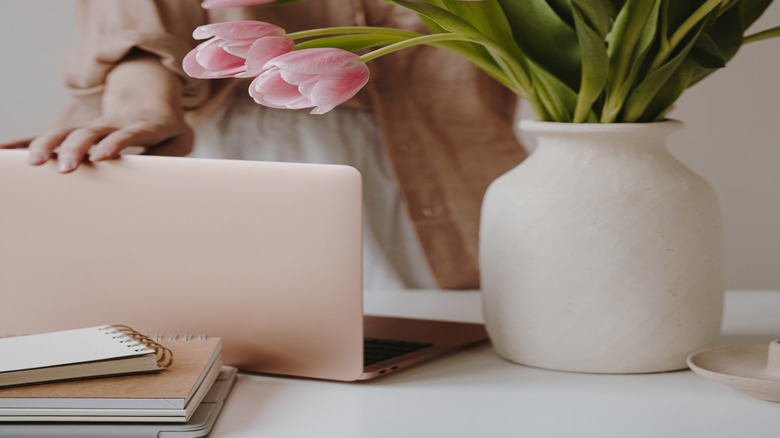Is An Ice Cube The Secret To Thriving Tulips? Here's What An Expert Says
Tulips come in many different varieties and colors, making them a popular option when trying to add a pop of color to your yard or home. These flowers are also sold at local grocery stores and nurseries as potted plants. If you have recently adopted a tulip plant or have had some for many years and love having fresh cut tulips in a vase, you may have heard about the hack circulating on social media that involves adding an ice cube to the container to extend the flowers' freshness. Is this really a good idea? Kim Zimmerman, owner of Rowdy Poppy, shared her thoughts on this hack in an exclusive chat with House Digest.
While social media promotes cool and unique tricks to improve almost every aspect of your day, it is important to consult authoritative sources before trying out these ideas. According to Zimmerman, this particular hack is best avoided. "My blanket statement about adding ice: I just wouldn't recommend it for a few reasons," she said. "First, it actually could damage the stems of the tulips by freezing the cells, which would end up doing the opposite of what we want." Rather than helping to support your tulips, the ice could actually help destroy the healthy growing process and potentially harm the flower you were trying to liven.
Why people try this hack and why it is probably not the best choice
Speaking exclusively with House Digest, Kim Zimmerman remarked that people usually add ice to their vase of tulips in the hopes of brightening the plant after it begins to grow long and sideways. "Some of that is just the natural progression of a tulip flower and I encourage people to celebrate how they change and arc and blow wide open as they age," Zimmerman explained. Understanding the natural growing progression of the plants in your home and garden could help you better identify issues that can harm your tulips if not prevented and what is simply natural growth.
Zimmerman also shared that from an environmental standpoint, the energy used to freeze water is not worth the little benefit the ice would give your flowers. "Even if it doesn't damage the flowers, it's quite a lot of energy used to freeze the water that may only provide a temporary bump in the perkiness of your blooms; I'm not sure the cost would be worth the result." Instead of adding unnecessary steps that will not actually help your flowers, Zimmerman suggests that you save the ice for something more practical — like using it in a cool drink after a day working in your garden.
How to keep your tulips from looking floppy
If you are looking to prevent your tulips from going floppy, do not fear. There are ways to prevent this from happening. Kim Zimmerman told House Digest in an exclusive interview that one easy way to temporarily help support the tulips is by keeping them in cold water and some cool air. "Perhaps an easier solution is to just trim the stems (because tulips continue to elongate in the vase which also contributes to the graceful flopping), place them in fresh water, and put them in your refrigerator for an hour (or even overnight)," Zimmerman explained. This is a similar method to what a florist would do to help keep their flowers looking fresh and could be used if you were looking to keep the flowers from flopping for a big event. However, if you are just trying to enjoy some cut flowers in your home, don't hide them away in your fridge. Instead, enjoy their beauty while they last.
While tricks and hacks can sometimes be useful for growing a beautiful garden, house plant, or even keeping flowers fresh, they do not replace the tested advise of a gardening expert on how to keep you cut flowers fresh longer. Zimmerman also noted that sometimes the small benefits of these ideas are not worth the greater impact they may have. "We love experimenting and support folks trying new things. Let's also consider the environmental impact of these tricks as part of evaluating their value. I think this one is a net negative." If you love cut flowers in your home, check out these flower vases for your next arrangement.


